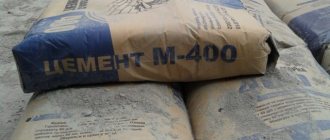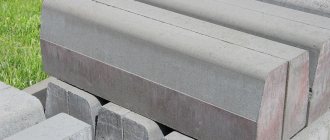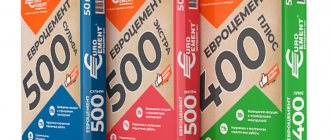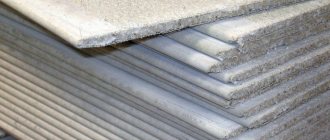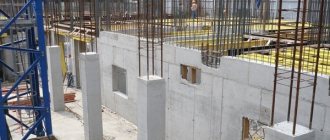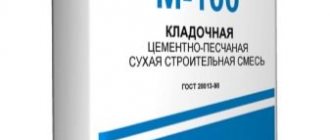Portland slag cement is a common component of building materials. Specific properties allow it to be used in the manufacture of various reinforced concrete structures. Despite the similarity with Portland cement, this variety has differences that expand the possibilities of using concrete in construction.
Composition and production
Portland slag cement is a finely ground powder that is obtained from several components in accordance with the GOST 1017-85 of the same name:
- Clinker with a magnesium content of no more than 5-6% (MgO reduces the quality of concrete stone);
- Blast furnace or electrothermometamorphic granulated slag – about 20-80% (depending on the expected characteristics);
- Gypsum minerals (natural pure gypsum, as well as containing phosphorus, boron and fluorine) - no more than 5% by weight of clinker.
The components of slag Portland cement are dried in heat chambers to 1%, then placed in a mill and ground to a fine powder of a homogeneous structure.
When choosing a material, pay attention to the designation of the regulatory document - only state technical specifications (GOST) indicate that the material does not comply with standard requirements. This will protect you from purchasing counterfeit or low-quality binder.
New marking of M400 mixtures
Most Russian manufacturers of cement mixtures are guided by the marking described above, but leading companies consider it outdated and use a new method from the European Union:
- CEM. The marking indicates the complete purity of Portland cement and the absence of additives in its composition.
- CEMII. Characterized by the presence of slag additives. Taking into account their concentration, two varieties are distinguished: class “A” (contain 6-20% slag), class “B” (contain 20-35% slag raw materials).
Since 2003, cement manufacturers have been practicing this European standard, additionally specifying parameters such as hardening time and performance properties.
The difference between Portland cement and Portland slag cement
Due to the use of slag, ShPC is much cheaper than ordinary Portland cement, but it also differs in some characteristics:
- It gains initial strength more slowly in comparison with Portland cement, but after 3 weeks of hardening its quality increases significantly;
- Portland cement does not contain slag; it is made only from clinker with a certain mineralogical composition and additional accelerator additives and improvers;
- Less pronounced exothermic reaction during hardening compared to Portland cement - concrete hardly heats up, which complicates working with it at temperatures from +4°C;
- Lower density and weight of the finished structure, respectively.
In order not to be unfounded, we present a comparison of the characteristics of these types of binders in the table:
| Parameter | Compound | Density of cement, g/cm3 | Strength, brand | Start and end time of setting | Distinctive properties |
| Portland cement | Clay and limestone clinker | 3,05…3,2 | 400, 500, 550 and 600 | 45 min. - 10 hours* | Durable material with long service life in normal environments |
| ShPC | Clinker, gypsum, slag | 3,0…3,1 | 300, 400 and 500 | Ready-made concrete stone is resistant to aggressive environments, but less strong and durable, heat-resistant |
*setting time of Portland cement depends on air temperature and ambient humidity, but slag binder has a longer hardening time.
The period of strength gain and bending test performance of samples are clearly shown in Table No. 2 of GOST 10178-85:
PC-D0 – designation of the amount of additives in percentage terms, “B” – quick-hardening binder.
INFORMATION DATA
1. DEVELOPED AND INTRODUCED by the Ministry of Construction Materials Industry of the USSR
DEVELOPERS
Z.B. Entin, Ph.D. tech. sciences; L.A. Malinina, Doctor of Engineering. sciences (topic leaders); E.T. Yashina; KBKpacnova; M.I. Brusser, Ph.D. tech. sciences; N.E. Mikirtumova; A.B. Morozov.
2. APPROVED AND ENTERED INTO EFFECT by Resolution of the USSR State Committee for Construction Affairs dated July 10, 1985 N 116
3. THE STANDARD IS FULLY IN COMPLIANCE WITH ST SEV 5683-86
4. INSTEAD GOST 10178-76
5. REFERENCE REGULATIVE AND TECHNICAL DOCUMENTS
| Designation of the referenced technical document | Number of paragraph, subparagraph | Designation of the referenced technical document | Number of paragraph, subparagraph |
| GOST 310.1-76 | 3.1 | GOST 5382-73 | 3.2 |
| GOST 310.2-76 | 3.1 | GOST 6613-86 | 1.10 |
| GOST 310.3-76 | 3.1 | GOST 22236-85 | 1.14, 2.1, 3.4 |
| GOST 310.4-81 | 3.1 | GOST 22237-85 | 4.1 |
| GOST 3476-74 | 1.5 | GOST 23464-79 | Introductory part, 1.2 |
| GOST 4013-82 | 1.5 | ST SEV 4772-84 | Introductory part |
6. REISSUE (October 1990) with Change No. 1, approved in April 1988 (IUS No. 8-88).
Change No. 2 was introduced, approved by Decree of the State Construction Committee of Russia dated December 28, 1998 No. 15 and put into effect from January 1, 1999.
Amendment No. 2 was made by the legal bureau "Code" according to the text of "BLS" No. 1, 1999.
An amendment was made, published in IUS No. 6, 2001
The amendment was made by the database manufacturer according to the text of IUS N 6, 2001
This standard applies to cements for general construction purposes based on Portland cement clinker.
The standard does not apply to cements that have special requirements and are manufactured according to the relevant standards and specifications.
Classification, terms and definitions - according to GOST 30515-97.
(Changed edition, Amendment No. 2).
Key properties of ShPC
Portland slag cement is divided into 2 types:
- Normal hardening;
- Quick-hardening (ShPTs-B) with additives - accelerators of mineral and volcanic origin (ash, pumice and others). The strength of this reaches the design value already by 7-14 days.
Portland slag cement does not tolerate temperature changes well, so hardening in cool conditions is significantly delayed. To speed up the process, it is not necessary to use additives - it is enough to treat the structure with heat (electrically heated formwork, heat guns). At elevated temperatures, the stone gains strength by the end of 28 days greater than ordinary cement under normal conditions.
Binder properties:
- The more slag there is in the composition, the longer the concrete hardens and the less heat is released during hydration.
- Slag cement exhibits shrinkage similar to ordinary Portland cement. It is noteworthy that with increasing grinding fineness and the amount of C2S (calcium-silicon compound belite), the volumetric expansion of the structure increases. For this reason, Portland slag cement is not recommended for use where shrinkage deformations are not allowed (roadbed, critical structural elements).
- The heat resistance of cement on slag is 600...800°C due to free Ca(OH)2;
- Due to the absence of active elements and dense molecular structure, Portland slag cement does not react with soft or sulfate water, therefore it is suitable for arranging structures in a humid environment.
The shelf life of ShPC is lower than that of conventional cement - only 45 days after factory shipment. Subsequently, the components lose their strength and waterproof properties.
Specifications
Cement M400 D20 has a number of technical characteristics that distinguish it from other solutions. The general parameters look like this:
- The compressive strength after 28 days of exposure corresponds to 39.2 MPa. 1 cm3 of such concrete can withstand loads of up to 400 kg.
- The density of M400 cement is determined by the size of the clinker and the type of additives in the composition. The specific gravity of cement varies from 1000 to 1200 kg/m³ in bulk form. A compacted solution can weigh up to 1700 kg/m³, and a moistened solution can weigh at least 3 tons.
- Hardening. The setting process begins after 2 hours, and the set of factory strength properties (up to 98%) occurs after 28 days.
- Resistance to exposure to aggressive environments with exposure to sulfates is low. To improve this indicator, PC D 20 cement with slag additives and other additives is added to the feedstock.
- Grinding grain size. Notifies about the specific surface area of particles contained in 1 kg of dry cement. The average varies from 3000 to 3200 kg/m³. The lower the value, the stronger the material will be after curing.
- The degree of frost resistance corresponds to class F100. This standard indicates the number of freeze and thaw cycles that the stone can withstand. The exact indicators are determined by the composition and ratio of the components. Alite and sulfate-resistant mixtures have the greatest frost resistance.
- Density. Notifies about the required volume of liquid for hardening in proportion to the dry mixture. The average varies from 22-28%.
- Heat dissipation. Indicates the degree of heat generation in case of hydration. If the material is subjected to uneven cooling or heating, it can become covered with cracks and deformations.
- Temperature range - from -60 to +300°C.
- Resistant to moisture. To make the material completely waterproof, it is enriched with sealing additives and waterproofing agents.
The volumetric weight of the cement material depends on the conditions of storage, movement and specifics of production. The presence of additives in the composition affects the density of Portland cement.
The average volumetric weight of cement varies from 1100 to 1200 kg/m³. If the indicator exceeds this value, the material has been stored longer than possible and has become very compacted. This can also be caused by loss of packaging sealing and excessive moisture.
The shelf life of cement when stored in a paper bag is six months. If you store cement in polyethylene containers and GOST packages - one year. But the initial characteristics of the material are preserved only if consumed within 2 months from the date of shipment.
Over time, the strength properties of the powder begin to decrease. The average is -100 positions in 2 months. This means that in 60-90 days the material will receive the M300 grade.
There is a general construction standard by which different grades of cement are classified:
- Cement PC 400 D0. It is distinguished by the absence of additional components and is based only on clinker. M400 D0 cement is characterized by improved frost resistance, average hardening time and vulnerability to deformation in case of shrinkage. The mixture is used for general construction purposes.
- M400 D5. This material contains up to 5% additives that increase resistance to moisture and corrosive processes. The mixture is suitable for arranging floors and load-bearing objects.
- Cement PC 400 D 20 contains up to 20% additives, which allow it to be used in residential and industrial buildings. The PC400 D20 brand is in demand not only in the Russian Federation, but also in European countries. It is characterized by frost resistance and water-repellent properties.
Increasing the concentration of additives in cement reduces its cost. The M400 D0 brand has the highest cost, and the M400 D20 eurocement is considered the most affordable.
Special brands with distinctive properties are offered for sale in Moscow, St. Petersburg and other cities of Russia and the CIS. So, there is a sulfate-resistant mixture suitable for aggressive operating environments. The packaging of such formulations bears the SS marking.
There is also expanding cement on the market that allows you to seal cracks and holes in walls. It can be used to fill cracks and restore the integrity of the structure. The material is characterized by resistance to deformation, so it is in demand when constructing foundations and performing repair work on underwater structures.
The characteristics of the material depend on the conditions and duration of storage after manufacture. You can purchase the material in paper bags, where all its properties are indicated, including production date, batch number and other important characteristics. The weight of the bag is 50 kg.
Areas of use
In terms of characteristics, Portland slag cement is almost as good as conventional binder for preparing concrete, so in civil engineering the material is often used to replace more expensive types of binder. By the way, in Russia the share of production of various types of ShPC is 25%, in Europe and America - over 50%. Judge for yourself: for private housing construction, the optimal grade of concrete is M400; M500 binder is suitable for its preparation. The cost of a bag of cement with slag is up to 20% cheaper than a similar package of PC. Considering the scale of construction, this amounts to a considerable sum.
Direct purpose of Portland slag cement:
- Manufacturing of prefabricated and monolithic structures in civil and industrial construction;
- Production of structures when accelerated hardening is necessary;
- Laying the road surface with quick setting of components;
- Production of concrete communication pipes;
- Construction of bridges and overpasses;
- Using ShPTs for mixing plaster and masonry mortars.
With all the advantages of slag Portland cement and good characteristics during operation, after 30...40 years (sometimes more, depending on the initial composition), the quality of the stone decreases sharply, as experts note. It is important to take timely measures to prevent the destruction of critical structures and their repair.
Preparation of concrete with slag
The main components of slag cement are the slag itself, clinker and gypsum in different proportions. The optimal ratio is indicated in documents and certificates; the process of preparing the mixture is identical to working with ordinary cement.
Composition of mixtures for preparing slag concrete
To get medium-grade slag concrete, it is enough to take 4-5 parts of a fractional mixture of slag, 2 parts each of sand and cement. You can reduce the cost of the solution by mixing cement and lime in a 3:1 ratio.
How to cook
A few hours before the intended mixing of the solution, it is advisable to moisten the slag with water to increase the service life of the concrete. Then all the components are mixed in the required proportions, gently stirred until smooth. The finished mass is used within an hour and a half.
Slag cement is a durable and highly effective mixture that is often used in a variety of repair and construction work. The proportions of the constituent materials can be changed to obtain the desired properties and characteristics.
Slag solution ratio
- Heated floor screed, component ratio Hello! Please tell me what is the optimal ratio of M-400 cement: sand: kisan plasticizer: water. Necessary for filling water...
- Is it possible to putty walls with Ceresite indoors? Do I need to add sand to it?
- Slag solution ratio How much slag, sand, cement, sawdust is needed?
- Please tell me the recipes for mortar mixtures, M25, M50, M200, M300 (cement) and cement-lime M25
- What is the thickness of the screed for slag insulation? What is the thickness of the screed for slag insulation and what is the ratio of sand and cement? I laid a hydrofilm on the ground and filled it with slag (product...
- Is foam plastic required for heated floors? Hello. The situation is this: on the second floor (the ceiling is concrete slabs) they decided to install a warm floor. We filled it with perlite sand and put it...
- Quantity of materials for laying tiles Please tell me how many bags of cement and amount of sand for mortar are needed to lay ceramics on the floor in a yard of 17 sq.m.
- What is the mortar consumption for cinder block masonry?
- Instructions
- Plastic windows, aluminum structures, protective roller shutters Plastic windows, aluminum structures, protective roller shutters, selection, production, installation
- Prefabricated houses from SIP panels Construction of houses from SIP panels
- Siding installation: basic installation recommendations
- What do you need to know when starting to install metal tiles?
- Insulation materials LINEROCK, Ecover, TechnoNIKOL, Tizol, Baswool Insulation materials LINEROCK, Ecover, TechnoNIKOL, Tizol, Baswool at competitive prices! For walls, ceilings, roofs!
What guides you when choosing paint?
Who are you in the construction industry?
For what purpose are you looking for information on our portal?
Granular slag
Article catalog > Bulk materials > Granular slag
Go to the price list for granulated slag
Slag production and types of slag
Slag is a non-metallic multicomponent melt that covers the surface of liquid metals during metallurgical processes, such as: smelting of feedstock, processing of molten intermediate product and refining of the liquid melt. At the end of metallurgical processes, the slag has a hardened stone-like or glassy state, also called an “alloy of oxides of variable composition.” In metallurgical production, slags appear accompanied by the process of ore reduction and extraction from it of the so-called waste rock, fluxes and coke ash during their chemical interaction with carbonate rocks. The main components of the slag are: acidic oxides SiO2 and TiO2, basic oxides CaO, FeO, MgO, neutral oxides Al2O3, ZnO. Thus, depending on the quantitative predominance of basic or neutral oxides, slags are divided into basic and acidic.
Division of slag depending on the type of production
Ferrous metallurgy slags:
— Blast furnace, which can be non-granular, granular, pumice.
Non-ferrous metallurgy slags
— Copper, nickel, aluminum (secondary), others.
Chemical industry slags
— Electrothermobasic
Ferrous metallurgy slag: blast furnace and steel foundry
In construction, the use of blast furnace slags obtained during the production of cast iron predominates.
Non-granulated blast furnace slag is produced by air cooling of the slag, followed by crushing and screening. The use of such slag is mainly observed in road construction as a replacement for crushed stone, as an additional filler in asphalt and concrete, in agriculture for soil deoxidation, and also as an iron-containing material for secondary smelting in blast furnaces. Non-granulated blast furnace slag does not have hydraulic properties.
Granulated blast furnace slag is obtained during the smelting of cast iron by rapid cooling with water in a granulating plant. Granulated blast furnace slag is used primarily as an active mineral additive to cement.
Slag pumice is called cast acidic slag. To create it, a specific cooling mode is required. There are no astringent properties. It is used as insulation (bedding under the floors of the first floor of houses), soundproofing material, necessary in the production of lightweight concrete and products made from it (cinder blocks).
Fig1. Ferrous metallurgy slag
The main useful characteristics of blast furnace slag are its basicity, resistance to grinding, reactivity, chemical composition and its stability. The density of slag is 2.7-3 g/cm3 (2700kg/m3-3000kg/m3), bulk density is 1.3-1.5 g/cm3 (1300kg/m3-1500kg/m3). The hydraulic properties of granulated blast furnace slag are determined by the value of the quality coefficient (K).
Depending on the quality factor and chemical composition, granulated blast furnace slags are divided into three grades:
| % Al2O3 (not less) | % MgO (max) | % TiO2 (max) | % MnO (max) | TO | |
| I grade | 8,0 | 15,0 | 4,0 | 2,0 | 1,65 |
| II grade | 7,5 | 15,0 | 4,0 | 3,0 | 1,45 |
| III grade | up to 7.2 | 15,0 | 4,0 | 4,0 | 1,20 |
Non-ferrous metallurgy slags
In construction and the production of building materials, non-ferrous metallurgical slags from the production of copper and nickel are of interest. Copper smelter waste slags are black in color and do not decompose. The density of such slag slags is 3300-3800 kg/m3, water absorption is 0.1-0.6%, compressive strength is 120-300 MPa.
Nickel slags have the same high physical and mechanical properties as copper slags. They are classified as acidic in chemical composition. They have a glassy phase, but despite this they have practically no hydraulic activity. The use of non-ferrous metallurgy slags is currently not large; they find a place for use in the production of cement and in the production of mineral wool and cast products.
Fig2. Non-ferrous metallurgy slag
Electrothermophosphorus granulated slags
They are waste from the production of phosphorus using the electrothermal sublimation method. They are obtained by rapid cooling of the silicate melt formed in electric furnaces when melting a charge of phosphorus ore, quartzite and coke.
Fig3. Electrothermophosphorus granulated slag
Price: 14560.0 rub for 20t
Price: 8400.0 rub for 10t.
Price: 12320.0 rubles for 15t.
Ferrous metallurgy slag (blast furnace)
There are 3 types of raw materials of this type:
- Granulated blast furnace slag, which is obtained by cooling cast iron during its smelting. As a rule, the resulting granulated slag is used as a substitute for more expensive mineral additives.
- Blast furnace slag is not granular type. It is extracted through the process of air cooling of metallurgical waste, its crushing and subsequent screening. The resulting material is most often used as a filler for asphalt concrete in the construction of road surfaces. In addition, non-granulated raw materials have found application in the agricultural field, where waste is used to deoxidize the earth.
- Slag pumice is different in that it does not have astringent properties. Therefore, this raw material is often used as insulation, soundproofing material and in the production of cinder blocks and other products made from porous and lightweight concrete.
If we talk about the properties of blast furnace slag, it is characterized by high resistance to grinding, reactivity and stability. Based on their hydraulic properties, granulated slag comes in three grades:
- 1st grade. In such material, the allowed content of aluminum oxide is not less than 8%, magnesium is not more than 15%, titanium is not more than 4% and manganese is not more than 2%.
- 2nd grade. Aluminum oxide – 7.5%, magnesium – 15%, titanium – 4%, manganese – 3%.
- 3rd grade. Aluminum oxide - no more than 7.2%, magnesium - 15%, titanium - 4%, manganese - 4%.

